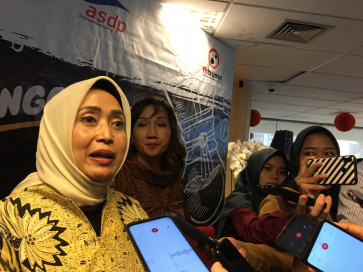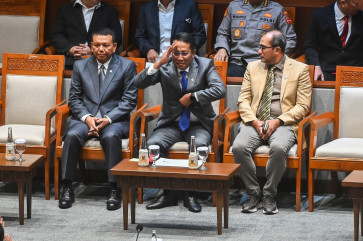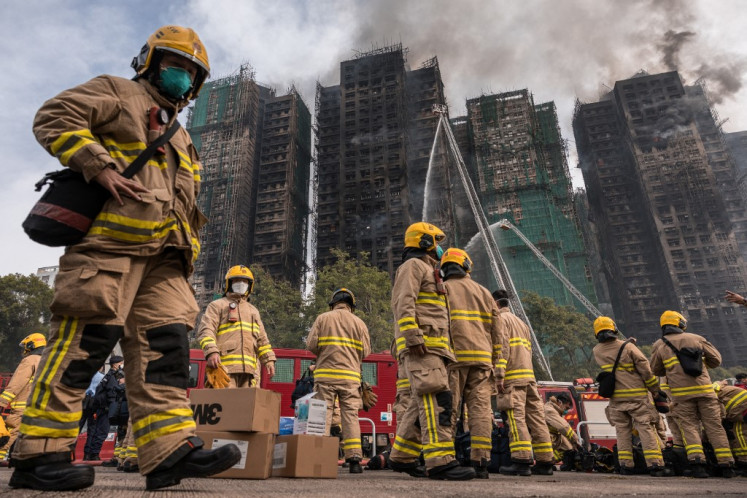Popular Reads
Top Results
Can't find what you're looking for?
View all search resultsPopular Reads
Top Results
Can't find what you're looking for?
View all search resultsRiau haze remains, thousands suffer respiratory problems
The haze in Riau, which has plagued the province since late January, is showing no signs of receding with over 14,000 people suffering from acute respiratory tract infections (ISPA) as they breathe in the polluted air
Change text size
Gift Premium Articles
to Anyone
T
he haze in Riau, which has plagued the province since late January, is showing no signs of receding with over 14,000 people suffering from acute respiratory tract infections (ISPA) as they breathe in the polluted air.
Based on data from the Riau Health Office, the highest number of patients with ISPA are in Rokan Hilir regency (6,661 people), followed by Pekanbaru (1,420), Dumai (1,237), Siak (1,232) and Bengkalis (1,092). Kuantan Singingi regency only has 15 people affected.
'None of the regencies have been spared from the affects of the haze,' said Riau Health Office's environmental health and disease control division head Erdinal on Tuesday.
Besides ISPA, four other health issues have surfaced, namely pneumonia, infecting 179 patients, asthma (314), eye irritation (205) and skin irritation (501).
'Every regency and mayoralty has been instructed to provide free treatment to patients affected by the haze. Treatment will be covered by the Riau provincial budget,' he said.
The Riau Health Office distributed 150,000 masks over the past week.
'On Feb. 16, 12,840 ISPA patients were recorded and that number rose to 14,093 in just two days. This has to be addressed,' said Erdinal, referring to the reasoning behind the dispersal of face masks.
'Regions severely hit by the haze have been told to close their kindergarten and elementary schools,' he said. 'So far, five regencies and mayoralties have imposed leave on students: Dumai and Pekanbaru municipalities and Siak, Pelalawan and Rokan Hulu regencies.'
According to Erdinal, younger children are especially susceptible to the haze. At Arifin Achmad General Hospital in Pekanbaru, for instance, almost half of its 70 ISPA patients are below the age of 14.
The Riau provincial administration extended its haze disaster alert status, which should have ended on Feb. 17, to next week as forest and peatland fires continue to burn.
'More than 6,000 hectares are affected as of mid February. They include oil palm plantations, community-owned sago and rubber farms as well as large-scale estates,' said Riau Plantation Office head Zulher.
Besides direct action by police, he added, the Riau provincial administration had carried out persuasive measures, such as speaking directly with forestry and plantation companies, who promised to cease the practice of slash-and-burn and help put out the fires.
Separately, Riau Police chief spokesman Adj. Sr. Comr. Guntur Aryo Tejo said the police in a number of regions had detained 10 suspects.
'We have only arrested 10 suspects ' all are members of the public: No companies have been named as suspects,' said Guntur.
Meanwhile, in Jambi province, the number of hotspots has increased. In February thus far, a total of 67 hotspots have been detected, as reported by the Jambi Disaster Mitigation Agency (BPBD).
Based on the BPBD report, the highest number of hotspots were found in the regencies of Tebo (41 hotspots), Batanghari (5), Sarolangun (4), West Tanjung Jabung (6), East Tanjung Jabung (1), Muaro Jambi (7) and Bungo (3).
'Some were detected in Berbak National Park. The investigation is ongoing,' said Jambi BPBD Emergency Response Division head Dalmanto on Tuesday.
He said his office would further discuss the matter with all the relevant agencies.










